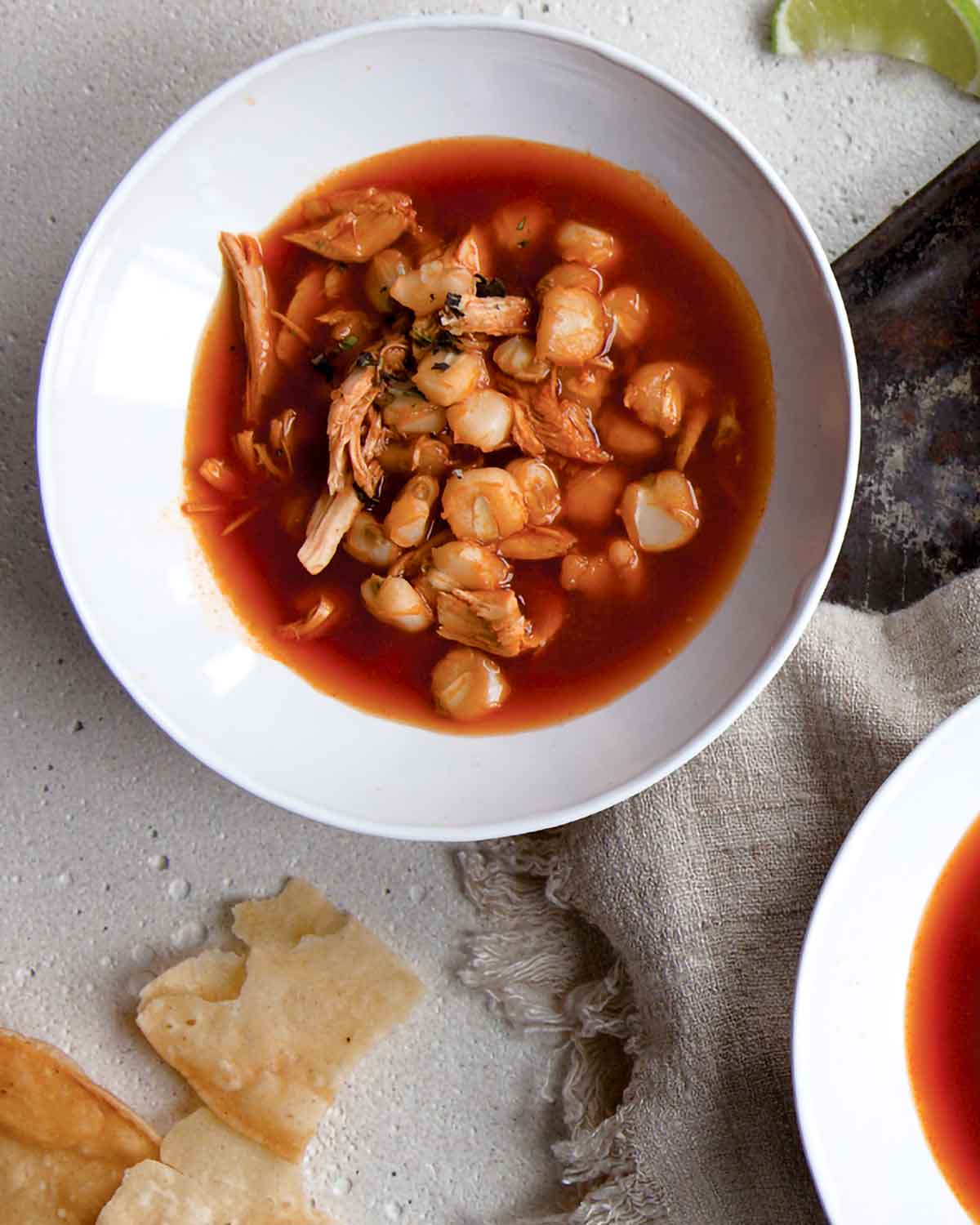
Chicken posole is a source of tremendous pride for Mexican home cooks. And, as you can imagine, there are as many recipes for this classic as there are families. This recipe makes a big batch and tastes even better when reheated, making it swell for feeding the family for a couple days or for entertaining a small crowd.

Why Our Testers Loved This
Our testers are calling this Mexican red posole soup “so very delicious,” “complex,” and “a fantastic meal.” They loved that it was “not difficult to prepare” and “reheated beautifully.” Kind of makes you want to try it, doesn’t it?
What You’ll Need to Make This
- Hominy–You can use canned or dried hominy. Using dried will require 3 to 4 extra hours of cooking.
- Chicken–The process of cooking the chicken pieces with the onion, cilantro, and salt in water allows the chicken to flavor the broth.
- Toppings–You can use any combination of your favorite toppings, including onion, cilantro, avocado, lettuce, radish, beans, tortilla chips, and limes. However, we strongly urge you to always include a squeeze of lime before serving as it really elevates the finished soup.
How to Make This Recipe
- If using dried hominy, simmer until it blooms. Season with salt. If using canned hominy, rinse and drain it, then add to a pot with 2 cups of water.
- Cook the chicken. In a separate pot, gently simmer the chicken with onion, cilantro, and salt until tender. Strain and reserve the cooking liquid and shred the chicken.
- Season the soup. Combine the shredded chicken in the pot with the hominy and water. Simmer until warm and season to taste.
- Make the chile purée. Rehydrate the dried chiles in boiling water, then blend the softened chiles with 3/4 cup of soaking liquid, onion, garlic, spices, and salt. Strain the purée.
- Finish the posole. Cook the chile purée until thickened, then stir it into the soup and simmer for 20 minutes. Serve with desired toppings.
Common Questions
The word pozole (pronounced po-so-LAY if in Mexico, po-SOL if in Central America, hence the interchangeable use of the word “posole”) comes from Nahuatl and means “foam,” explains author Pati Jinich. The hominy expands while it cooks and opens in such a way that it appears to bloom—and in so doing it forms some foam on the surface of the cooking liquid. “That’s how you know when it’s ready,” explains Jinich.
Sometimes these words are used interchangeably but they’re not really the same thing. If you want to get food nerdy about it—and you know we do—then here’s a handy definition for you.
Hominy is the corn kernels that’s been soaked in lye water to remove the hulls, which allows them to swell to outsized proportions. When you take those big ole kernels of hominy and add them to a pot of brothy chicken, and chiles, you get, in this, red chicken pozole. And when you’ve got posole, what else could you ask for?
Yes, since this red posole soup reheats exceptionally well, and its flavor improves over time, it can be made up to 3 days before serving. It can also be frozen for up to 3 months. Thaw overnight in the refrigerator before reheating.
Serve this soup hot, topped with all of your favorite garnishes, including sliced radish, avocado, lettuce, onion, cilantro, chiles, and tortilla chips or strips.
Helpful Tips
- To make posole in the slow cooker, try this slow cooker pork posole.
- For smaller batches, this recipe can be halved.
- Reheat leftover posole in the microwave or in a saucepan over medium-low heat.
- If using a high-powered blender, like a Vitamix, when making the chile puree, you can skip the straining step, if desired.
- This recipe is suitable for gluten-free and dairy-free diets.
Write a Review
If you make this recipe, or any dish on LC, consider leaving a review, a star rating, and your best photo in the comments below. I love hearing from you.–David
This is what pozole should be. Simple and delicious, with simple ingredients.
frawgster
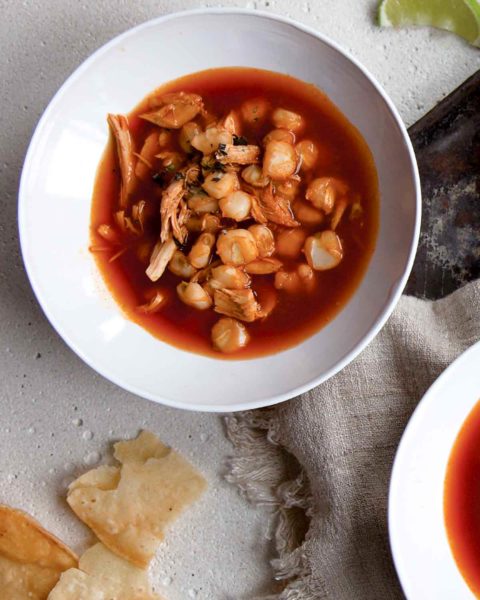
Red Chicken Posole
Ingredients
For the chicken posole base
- 1 pound dried hominy, (also called maíz mote pelado or giant white corn) or three 29-ounce cans hominy, drained and rinsed
- 1 head garlic, papery outer layers removed (if using dried hominy)
- Kosher or coarse sea salt
- Two (3-pound) chickens, cut into serving pieces
- 1 white onion, halved
- 5 cilantro sprigs
For the chile purée
- 2 dried ancho chiles, rinsed, stemmed, and seeded
- 3 dried guajillo chiles, rinsed, stemmed, and seeded
- 1/4 cup chopped white onion
- 3 garlic cloves, chopped
- Pinch ground cumin
- 2 whole cloves
- 1 teaspoon kosher or coarse sea salt, or to taste
- 3 tablespoons vegetable oil
For assembly
- 5 to 6 limes, halved
- 10 radishes, halved and thinly sliced
- 1 head romaine lettuce, leaves separated, rinsed, dried, and thinly sliced
- 1/2 cup chopped white onion
- Dried ground chile, such as piquín, or a Mexican mix such as Tajín
- Dried oregano, preferably Mexican
- Tortilla chips or tostadas
- Refried beans (homemade or store-bought)
Instructions
Make the posole base
- If using dried hominy, place it in a large pot, add enough water to cover the hominy by at least 4 inches (10 cm), and then toss in the head of garlic. (Don’t add salt before or during cooking or the hominy will toughen.) Bring the water to a boil and then reduce the heat, cover partially, and gently simmer over medium-low heat until the hominy has “bloomed,” or opened, 4 to 4 1/2 hours, skimming the foam from the surface and adding more water as needed. The hominy will be chewy. Remove from the heat and add 2 teaspoons salt.If using precooked or canned hominy, dump the drained and rinsed hominy into a large pot and add 2 cups cold water.
- Place the chicken in a large pot and add enough water to cover by at least 2 inches. Add the onion, cilantro, and 1 tablespoon salt. Bring to a boil and then reduce the heat, cover partially, and gently simmer over medium-low heat until the chicken is cooked through and tender, about 40 minutes.
- Remove the chicken from the pot and let cool. Strain and reserve the cooking liquid. When the chicken is cool enough to handle, remove and discard the skin and bones and shred the meat.
- Return the shredded chicken and its cooking liquid to the pot along with the hominy and place over medium heat until warmed through, about 10 minutes. It should be soupy. Taste and add more salt if necessary.
- Remove the pot from the heat and set it aside while you make the chile purée. (You can cool the posole to room temperature, cover, and refrigerate for up to 3 days.)
Make the chile purée
- Place the ancho and guajillo chiles in a medium saucepan, add just enough water to cover, and bring to a boil over medium-high heat. Simmer until softened and rehydrated, about 10 minutes.
- Place the chiles and 3/4 cup of their soaking liquid in a blender or food processor along with the onion, garlic, cumin, cloves, and salt and purée until smooth. Pass the purée through a fine-mesh strainer into a bowl, pressing on the solids with the back of a wooden spoon to extract as much liquid as possible. Discard the solids.
- Heat the oil in a medium saucepan over medium heat until hot but not smoking. Add the chile purée and bring to a boil, then cover partially and simmer, stirring occasionally, until thickened, 6 to 8 minutes. Remove from the heat.
Assemble
- Reheat the posole over medium-high heat until it comes to a gentle simmer. Stir in the chile purée and cook for 20 minutes. Taste and adjust the salt.
- Ladle the red posole into bowls and pass the limes, radishes, lettuce, onion, ground chile, dried oregano, tortilla chips or tostadas, and refried beans in bowls so each diner can fancy the posole up as they like. One topping that probably ought not be optional is the lime—go ahead and squeeze it liberally over the posole. One taste of how that bright acidity rounds things out and you'll understand.
Notes
- Storage–Posole can be made up to 3 days before serving or frozen for up to 3 months. Store in an airtight container in the refrigerator or freezer.
- Reheating–Warm the pozole in a pot over medium-low heat, or in the microwave until heated through.
- Scaling–This recipe can be halved.
- Dietary–This red pozole is suitable for gluten-free and dairy-free diets.

Nutrition
Nutrition information is automatically calculated, so should only be used as an approximation.
Recipe Testers’ Reviews
Oh, this red chicken posole recipe was so very delicious.
Although not difficult to prepare by any means, it does take time to cook each component before the final assembly, so it’s best left for a weekend dinner. You can find junctures where components can be made in advance and stored, as when the meat is shredded and the hominy is boiled. The chile pureé can also certainly be made ahead of time and stored in the fridge.
I halved the recipe and didn’t encounter any issues. I used canned hominy, which was fine, although you do need to be careful about the accuracy of your final simmering time—you don’t want to overcook the corn.
It reheated beautifully the next day for a quick office lunch. I’d never had the red version before, and I think it’s my new favorite.
Pozole is a standard in our home, where I make it at least once every 2 or 3 months. But I’d always made the white version. Time to try out something different. In the end, the two posoles are identical except for the chile sauce in the red version. The chile added a somewhat earthen flavor to the dish. I’ll make this recipe again.
I didn’t use dried hominy but opted for canned instead. I’ve used dried hominy before but I didn’t think the taste was that much different. As accompaniments, I used most of the things mentioned in the recipe, but I added diced avocado and minced cilantro on top of the refried beans.
There seemed to be a lot of ingredients and steps to making this red chicken pozole recipe, but all in all, it was just chicken, chiles, and hominy. This very simple combination ended up tasting complex and delicious. It had just a hint of heat, and while the hominy and chicken were soft, the addition of the crunchy accompaniments made for a tasty dish.
I’ll definitely make this again and combine the chicken with the pork.
I used canned hominy but wonder how cooking the dried hominy with a head of garlic would have changed the flavor. Also, there was a lot of broth left after poaching the chicken, and not having made this before, I had to guess how much liquid I should put in.
I finally got to use the dried chiles I’ve been hoarding, so there was no problem getting both the ancho and guajillo.
With this red chicken pozole recipe, you have the potential for a fantastic meal, made hearty from the hominy, chicken and chiles, with bright, fresh tastes and textures from the lettuce, radish, and lime.
I used dried hominy and it really does add a richer flavor. And you’ll have the cooking liquid from the hominy to use as part of your broth for the final stew.
The name the author gives for the appropriate dried hominy to buy, maíz mote pelado, is correct. “Pelado” is the operative word, which means that the skins have been removed. This is corn that has been treated with slaked lime (cal), had the skins rubbed off, then dried again.
The recipe is a bit vague on quantities, especially liquids. I cooked the hominy in a 5-quart pot with 10 cups of water. This was less than 4 inches above the hominy, as the recipe specified, but it was plenty. After the hominy was cooked, which took about 3 hours, rather than 4, it left me with 1 quart of cooking liquid.
The instruction not to add salt is an old wives’ tale, just like the old saw about not adding salt to beans. I added the 2 teaspoons salt as called for from the get-go. I added another teaspoon later in the cooking, so 1 tablespoon turned out to be the right amount.
For the chicken, I used a single 5 1/2-pound chicken, cut up, in a 4 1/2-quart pot with enough water to just barely cover it. Once again, not as much water as the recipe called for. After the chicken was cooked, cooled, and shredded, I still had almost 1 quart of extremely rich (gelatinous) stock, which was more than enough for this recipe.
When combining the chicken, chile paste, and hominy, instead of adding all the cooking liquid from the hominy, I drained the hominy, and added 2 cups hominy cooking liquid and 2 cups chicken stock. This was sufficient for a fairly thick, robust chicken pozole, but if you want it soupier, there’s enough of both the chicken stock and hominy liquid left to add more.
For the chile paste, I processed mine in a Vitamix, which made it very smooth, so I omitted the step of passing through a sieve. If you use a regular blender, you may want to take the trouble.
For the garnishes, I used Tajin for the chile powder, which is a seasoning that combines dried chiles, lime, and salt. It’s neat stuff to have around for putting on grilled corn. If you don’t use this, you’ll need more lime and some extra salt.
The fresh vegetables should be placed generously on top of the chicken posole, and offer a nice cool, crunchy contrast to the hot soup.
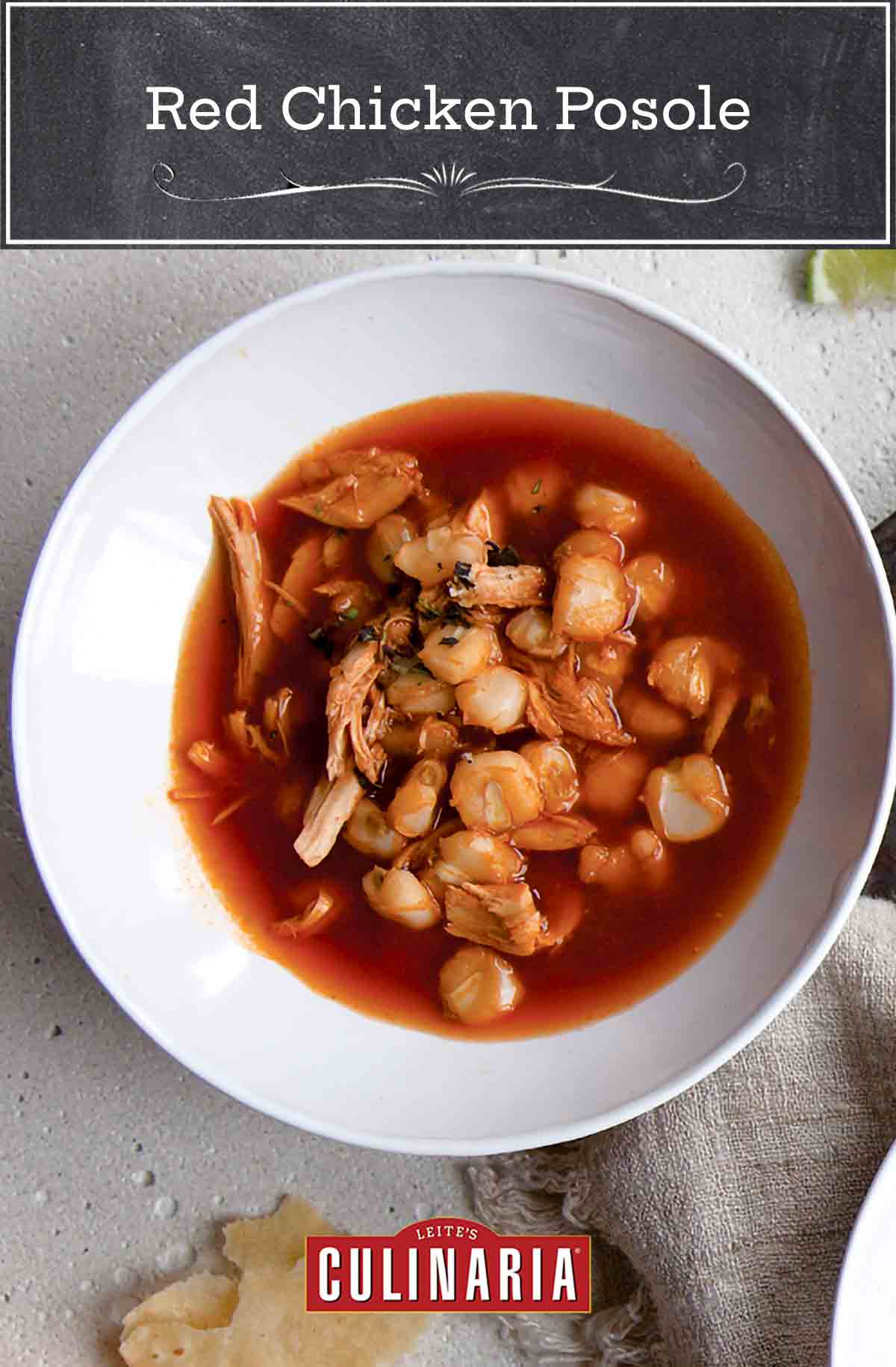
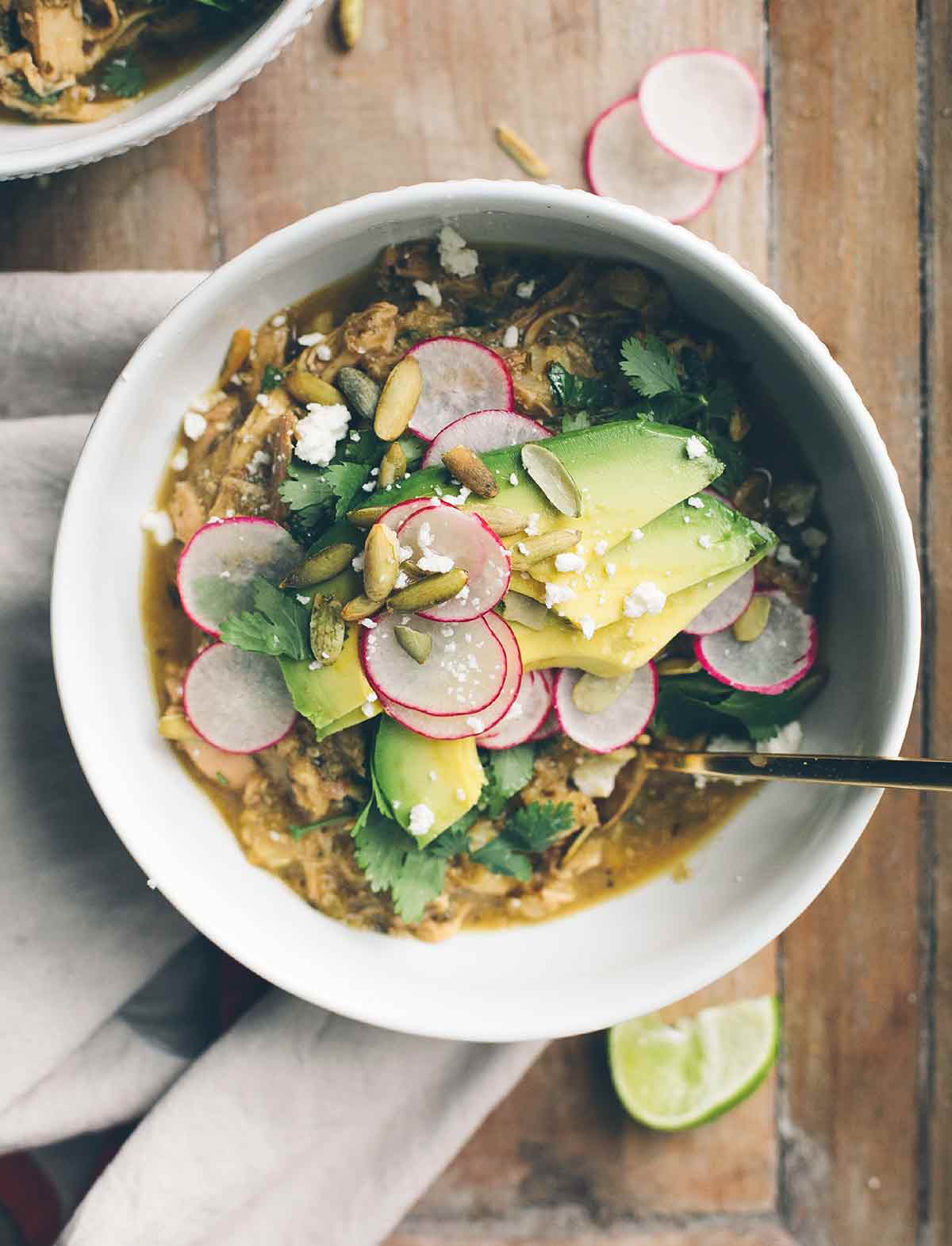
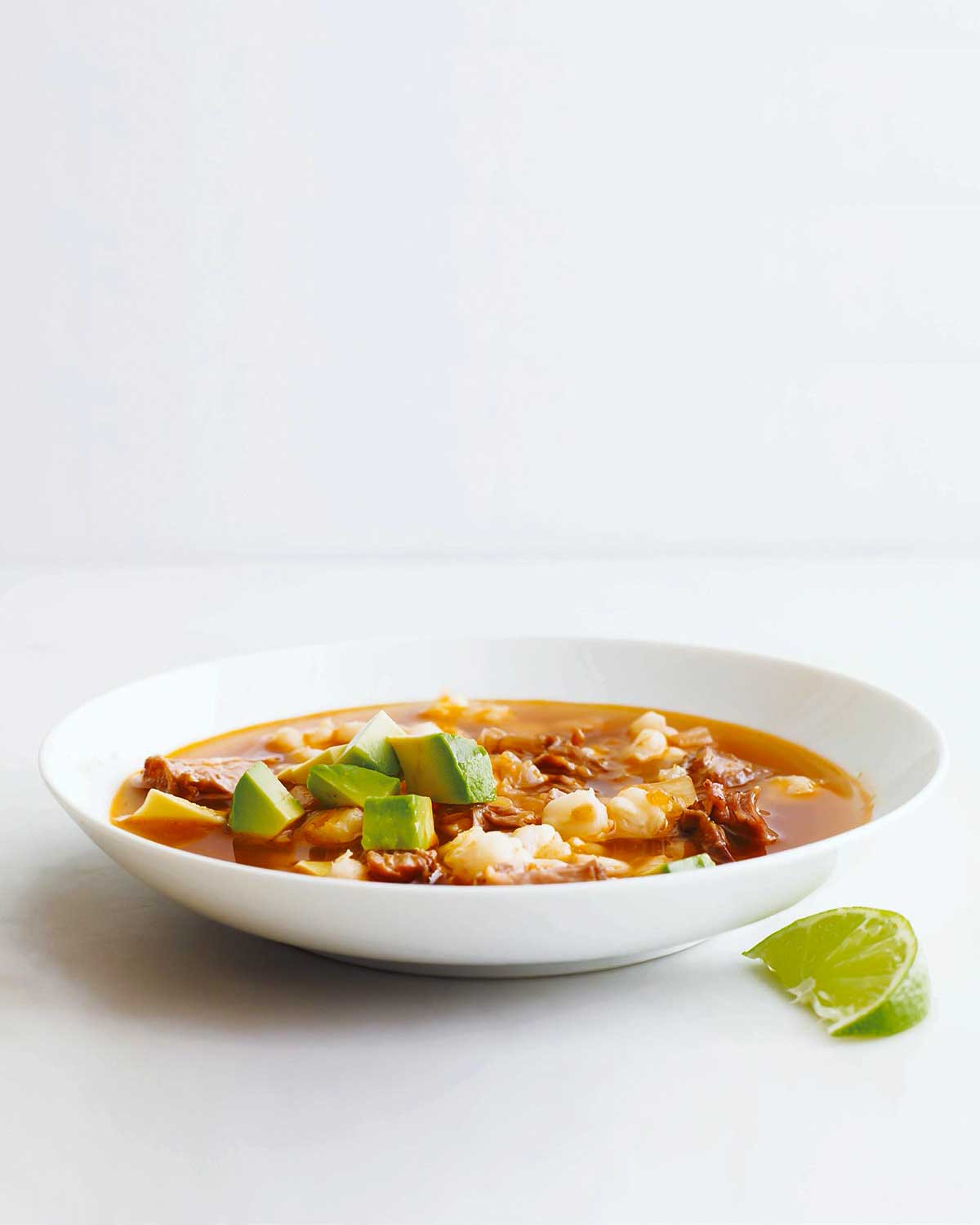















My Mexican sister-in-law taught me how to make her version of chicken pozole, and this recipe is the closest to what she showed me. In her chicken soup/broth, she definitely used a lot of oregano and white onion, but strained it out to make the pozole. Toppings? Lots of thinly sliced radishes, white onion, cabbage, cilantro, and limes. And when I asked questions about other things, she always would just say, “Oh, whatever you like! If you have avocado and want to put avocado on it, do it! Cucumber? Do it!”
There are a lot of variations from family to family, and regionally as well. Pork, chicken, beef, white pozole, green pozole, red pozole, so don’t be afraid to experiment. Make it as spicy as you want. Make it thick like stew, or add more liquid and have it more brothy! Just make if often, and play with it until you get it just the way you like it best. You can’t really go wrong.
She’s from a little ranch in Nayarit, so another condiment she always uses is Salsa Huichol, but I know I saw a big bottle of Sriracha on their table the last time I was down there.
Love it, Caitlin! All of it! Thanks so much for taking the time to share some inspiration for our upcoming batches of pozole…
You brought me back to my student days in Cholula, Puebla, and all the marvelous regional dishes we devoured. Stomach trumps brain for great memories. Gracias, elena
Ah, I envy you those experiences, elena! And yes, absolutely, stomach always trumps brain…
Can you use Chile California and Chile new mexico instead ..?
Rebecca, we didn’t test the recipes with those specific chiles, so I can’t say with 100% certainty that your substitution will work spectacularly. (That’s why we test recipes—so that we can only publish those recipes that are truly worthy of your time and ingredients!) But I think that should be fine. California chiles are incredibly mild, and New Mexico chiles are not much hotter, so I think you’d end up with a really nice, richly flavored, not overly hot pozole. Please let us know how it goes!